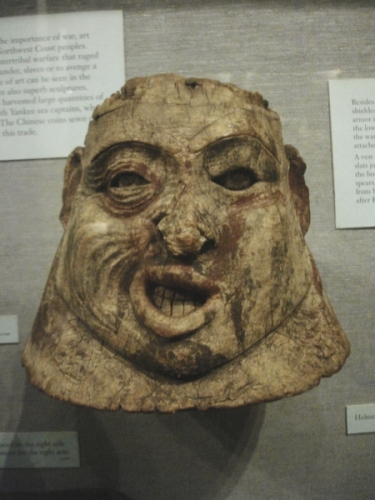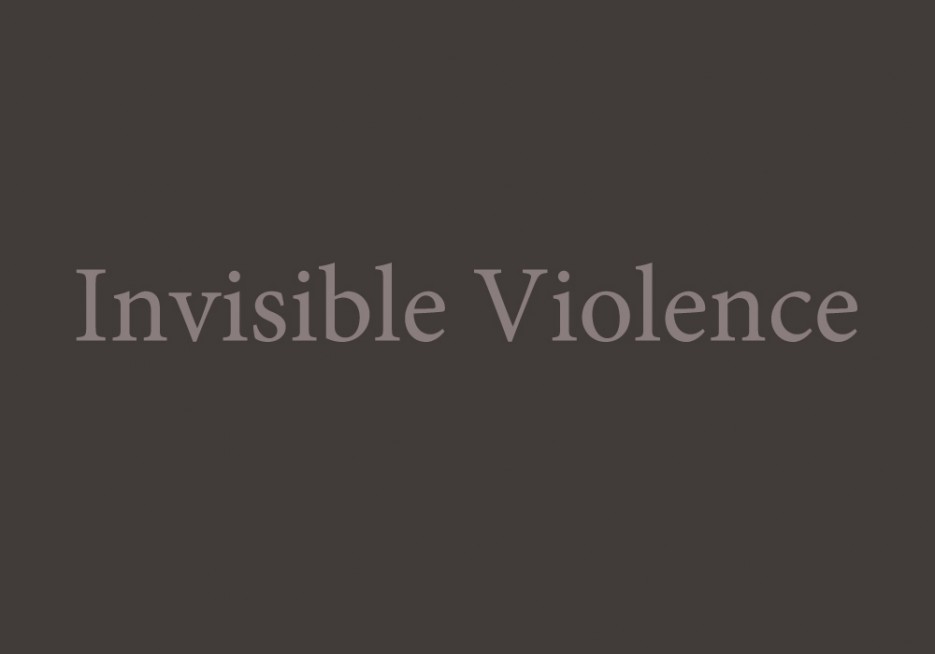On February 15, Artspeak, in partnership with Simon Fraser University Community Engagement, hosted an artist talk by Marianne Nicolson to mark the Vancouver launch of Invisible Violence. Nicolson is a member of the Dzawada’enuxw Tribe of the Kwakwaka’wakw First Nations. She is an artist and linguist, currently completing her doctoral thesis at the University of Victoria on the conceptualization of space and time in Kwakwaka’wakw language. During the talk, she showed photographs taken of her community in the nineteenth and early twentieth centuries in belief that Indigenous Peoples were vanishing. Nicolson spoke about her community’s re-reading of these photographs as well as her own artworks as a way to relate to how the artists in Invisible Violence negotiate the underlying conditions of epistemic violence. Vancouver-based artist and writer Sean Alward responds in this text.

Slippery Bond
By Sean Alward
The contingent, slippery relationship between words and pictures was a recurring thread during Marianne Nicolson’s eloquent artist talk responding to Liz Park’s curatorial theme, “Invisible Violence.” Nicolson showed a variety of images, all of which addressed the uneasy and often violent interaction between Northwest Coast First Nations’ culture and colonial settler society. She incorporated this larger historical context with her own personal subjectivity by including archival photographs, postcards, family photos, and images of her own artwork. Photography is an index of the conditions of its creation, even when this information is not readily apparent in the images. Questions must be asked, who made the photos, for what purpose, and how were they actually used? What lies outside the optical frame of the photograph, its larger context, is essential when considering the medium’s capacity to convey the experience of violence in the real world. Thus film-maker and theorist of photography Ariella Azoulay expresses the need to consider the “photographic event,” rather than the event photographed.
The main “event” or context addressed in Nicolson’s talk was the historical suppression of Northwest Coast culture, first by the British colonial government and later by the government of Canada. This encompassed both physical violence and socio-cultural violence legislated through government policy, such as the banning of the potlach and the later forced enrollment of aboriginal children in residential schools. These policies of assimilation left no room for considering “distinct societies.” First Nations populations had dwindled to a minority in their own land through a combination of decimation by disease and overwhelming numbers of settlers. Estimates vary as to how many people died in the first century of contact, but they range from around 60% to 90% of the total population. Communities were traumatized by mass death.
Nicolson showed a late nineteenth century photograph of a Northwest Coast longhouse with several women seated in front, hiding their faces from view with their arms and shawls. Above them is a painted sign, publicly declaring how many coppers had been broken (a way for chiefs to demonstrate wealth) during a potlach ceremony. The sign is blatantly declarative. Look here and know this. In contrast, the women are seen but anonymous. The colonial interloper with the camera likely did not and could not see his own act of photographing within the same context of inequality and trauma that present-day audience understands of this particular moment in history. Looking at the image now, the women’s gesture is not only a form of resistance to the photographer, but to the spectators, including Nicolson’s audience. Nonetheless, the women are still the subjects of the all-consuming lens; they become not just documentary subjects in an historical context, but aesthetic elements in a picture. The implication of the camera’s ability to aestheticize all things is as ethically uncomfortable as it is unavoidable.
This conundrum and the general instability of viewing a photograph, when considering the historic “photographic event,” can be controlled by a presenter or curator to some degree through a careful choice of words. However, once an image escapes this controlled environment, all bets are off. A photograph is not a linguistic artifact. It is a visual one. Any hold language has on it will be contingent on who shows a photograph, how, and why.
How does the viewing dynamic change when the photograph in question depicts an art object or is meant to be a piece of art in itself? Nicolson showed a photograph of several masks arranged haphazardly on low shelves. She informed us that the masks had been confiscated by Indian Agent William Halliday from the community of Kingcome Inlet, during the potlach ban (1884-1951). The photograph was taken by the confiscator himself, Mr. Halliday. Later, he sold off many of these masks, without consent from their rightful owners, to various museums across the continent. The image was interesting for its casual presentation of the masks, though not particularly remarkable until its history was explained. Clearly this photograph was not meant to be an art photograph but a documentary record of forbidden indigenous art. However, if the photograph were to be re-contextualized by an artist today and presented as art (which Nicolson was not attempting), what kind of independent agency would the image have and to what degree would it be at the mercy of its new context? Is the social violence of the original photograph only communicated through language and context? Does it reside in the image? If the image is considered aesthetically, how does this affect our understanding of the original social violence?
The permeable nature of interpretation applies to all kinds of artifacts. I had a personal experience of this a couple of years ago while in New York visiting the American Museum of Natural History. It contains the largest collection of Northwest Coast Indigenous art in existence, which was assembled during the same time period as the early photographs Nicolson showed. Walking through these displays today it looks as though it is how museums looked a century ago, with large mahogany cases piled full of objects behind glass with paper labels – a dusty warehouse of artifacts.
While strolling by the display cases one object caught my attention: a wooden helmet with a peculiar life-size grimacing face on the front. It was like a mask. The face looked to me like a cartoonish caricature, vivid, engaging, and very real, if not realistic. The carving was fantastic and I was moved by the lively intelligence of the object. Was it the face of a clown, a buffoon, or was it meant to ridicule someone or something? The label didn’t say much, just that it was a Tlingit helmet collected sometime between 1888-93. I took a photo and flew back to Vancouver.
A couple of years later I encountered the helmet again while reading about the establishment of the museum and its collection. It turns out that the comical face that I was so impressed with was actually meant to represent a man being beaten to death with a blow from a war club to his head. The beautifully rendered grimace represents the powerful contortion of pain or paralysis that occurs when such violence strikes a human body.
I still find this artifact as moving and vivid as before. But now, how do I reconcile what my eyes experience and what I have learned about it via language? Is it still possible to experience pleasure looking at it? Even with the information I now have, I still know nothing about who made this strange object or its original context. I can’t even examine the actual helmet. It is now a photograph.
